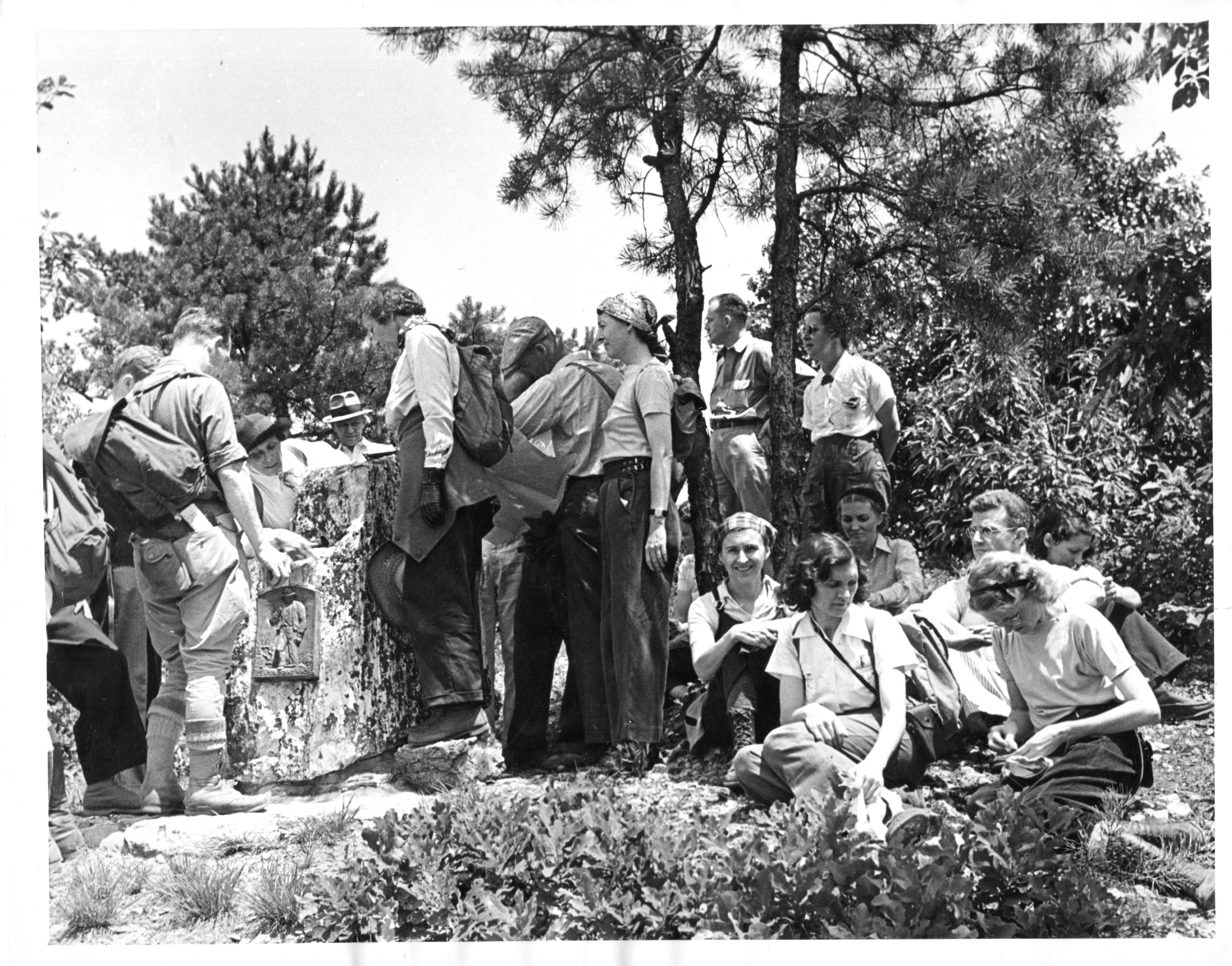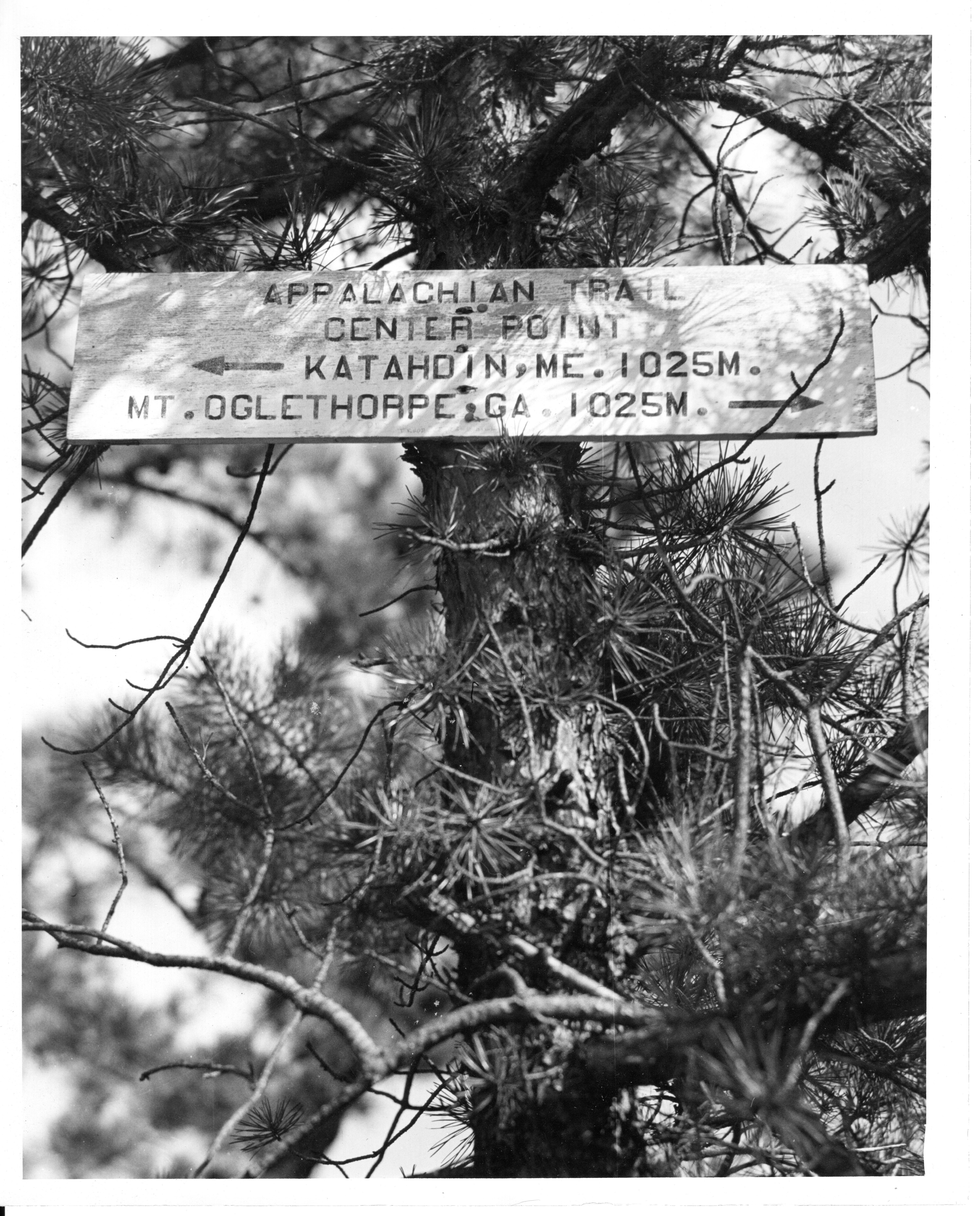Iconic Locations: Center Point Knob
Have you ever wondered where the center point of the Appalachian Trail is? If you guessed Center Point Knob, Pennsylvania you would be wrong. But it was the location of an infamous crime. Well sort of.

Original sign at Center Point Knob, Potomac Appalachian Trail Club Archives
[nature sounds]
MILLS KELLY: There’s something satisfying about reaching the halfway point of a hike. It’s a nice milestone that keeps you going to the end. Whether you’re hiking for a day, a couple days, or a couple months, you eventually reach halfway. And on a long trail like the Appalachian Trail, that halfway point can feel especially sweet.
[nature sounds end]
[intro music]
KELLY: Welcome to The Green Tunnel, a podcast on the history of the Appalachian Trail. My name is Mills Kelly, and I’m your host. Today, we’re taking you to Center Point Knob, the sort of halfway point of the Appalachian Trail.
KELLY: Thanks to detours, reroutes, and other factors, the halfway point of the trail changes every year.
KELLY: These days, just south of Pennsylvania’s Pine Grove Furnace State Park is a sign that marks the halfway point of the trail.
KELLY: It’s in the park that you’ll find many milestones, like the Appalachian Trail Museum and the “half-gallon challenge,” where hikers attempt to eat a whole half-gallon of ice cream in one sitting.
KELLY: But Center Point Knob used to be, well, the center point. And it became the scene of an infamous crime.
KELLY: Well, sort of.
KELLY: Mount Katahdin has always been the northern terminus of the AT, but you may remember from an earlier episode that until the late 1950s Mount Oglethorpe used to be the southern terminus. At that time, the halfway point of the trail landed on an unnamed prominence in Pennsylvania.
KELLY: In 1935, the Mountain Club of Maryland installed a bronze plaque on a boulder on that rise, commemorating the midpoint of the new AT and appropriately naming it Center Point Knob.
KELLY: That bronze plaque, embedded in the face of the boulder, depicted a backpacker cresting a mountain and includes the famous AT logo and the words Center Point Knob. It replaced a plain wooden sign that said, simply, Center Point Knob. Mount Katahdin, Maine 1025 miles. Mount Oglethorpe, Georgia 1025 miles.
KELLY: Well, someone loved that plaque so much that they stole it, sometime between 1940 and 1948. I know the plaque was there in 1940, because I found a photo in the Potomac Appalachian Trail Club archives from that year with a group of club members standing around it. We’ve posted that picture in our show notes on our website.
[music ends]
KELLY: But by 1948, the plaque was gone and the trail went cold.
BRUCE DUNLAVY: There’s a photo of Earl Shaffer standing at Center Point Knob. That photo was taken in 1948 and that photo stuck with me for a few different reasons, I could stand at the very same spot at that very distinct boulder. And in that photo 1948 the plaque was long gone.
KELLY: That’s Bruce Dunlavy, a long-time member of the AT community who has lived near Center Point Knob since the late 1980s.
KELLY: Whoever decided that the plaque would make a great souvenir didn’t feel the same way about the boulder it was attached to. After all, it’s kind of large. For decades, that boulder, with bolts sticking out of it, was the only indication that you’d reached the trail’s sort of halfway point. Until…
DUNLAVY: 1994, Wilmer Harris had contracted me to build a log home in the woods at the base of the South Mountain. And that's just downhill from the Campbell Spring Shelter and Center Point Knob. His home was finished later that summer. And ultimately, one of the final details was to install a mantel on the wall behind the woodstove. So, at some point after installing the mantel, I visited the home and noticed the Center Point Knob plaque on the mantel.
KELLY: Bruce knew immediately exactly what that plaque was, and you can imagine his surprise when he saw it.
DUNLAVY: Yeah, it was a little bit of a shock. I didn’t know what to say, you know, I knew what it was pretty instantly, in spite of never seeing it before. So plenty of questions, didn’t know how to ask. And you know, I didn’t want to insult Wilmer either, you know, he was my customer. So I think I just kept quiet about it. (00:14:26)
KELLY: But how did Wilmer end up with the infamous missing plaque? According to Bruce, it was just by chance.
DUNLAVY: His story was that he had been digging fence posts, went to dig a hole for setting a post and there it was.
DUNLAVY: Everyone just assumes that whoever decided to pry it off the boulder, was only committed to carrying it so far. And by the time they reached the base of the mountain, they were done carrying it.
KELLY: Bruce kept his knowledge of the plaque to himself, at least for a while.
DUNLAVY: I imagined he knew what it was. And you know the conversation didn't really happen initially, I kind of let it let it ride for you know for about a decade or so.
KELLY: About a decade after he finished working for Wilmer Harris, the Appalachian Trail Museum began to take shape at nearby Pine Grove Furnace State Park under the guidance of Larry Luxenberg. And Bruce had not forgotten about Center Point Knob’s missing plaque.
DUNLAVY: I didn't really have a conversation with Wilmer about the plaque until you know, I was in touch with Larry. That's kind of when my wheels started turning, that you know, you know, I could I could approach Wilmer and see if he'd be he'd be interested in basically handing the plaque over.
DUNLAVY: He didn't have any major hesitation, he had had the plaque for for decades and decades. And yeah, he thought it was a good idea.
KELLY: Finally, the prodigal plaque was returned to the Appalachian Trail. But instead of taking it back up to Center Point Knob, the Mountain Club of Maryland decided to take a mold of it and cast a new one. And just like in the 1930s, the Club mounted this new plaque on the boulder on Center Point Knob in 2011. The original plaque now lives in the Appalachian Trail Museum for everyone to enjoy.
KELLY: In the summer of 2018, I hiked the trail through Pennsylvania from Penn Mar to Duncanon. I crossed over Center Point Knob on my way north. And as I stood there on a foggy morning in June, I imagined what it must have felt like for those early AT hikers to reach their halfway point. For me, it was one of those moments when the history of the trail really came alive.
[Outro music]
AMBER PELHAM: The Green Tunnel is a production of R2 Studios at the Roy Rosenzweig Center for History and New Media at George Mason University. Today’s episode was produced by me, Amber Pelham, and Hayley Madl. Jeanette Patrick and Jim Ambuske are the executive producers.
PELHAM: At R2 Studios we’re on a mission to democratize history through podcasting, and we invite you to join us. So, head to R2Studios.org and click on “Support Us” to help us make the best history podcasts out there.
PELHAM: That’s it for today. Thanks for listening and we’ll see you again soon!
Bruce Dunlavy
Bruce grew up in south-central Pennsylvania and graduated from The University of Maryland in 1988 with a BS in business. He built homes until 2006, and his dream of walking the Appalachian Trail was realized in 1996. He walked the Pacific Crest Trail in 1999, and in 2002 he started to walk the Continental Divide Trail. Two weeks after reaching the Canadian border he welcomed his son Riley Skye. In 2005 he started The Great Divide Trail in the Canadian Rockies. He and his wife Susan spend their winters on the Big Island of Hawaii. During Spring and Fall, they live in Pennsylvania, just a short walk to Center Point Knob.











